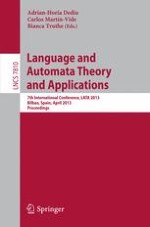This book constitutes the refereed proceedings of the 7th International Conference on Language and Automata Theory and Applications, LATA 2013, held in Bilbao, Spain in April 2013.
The 45 revised full papers presented together with 5 invited talks were carefully reviewed and selected from 97 initial submissions. The volume features contributions from both classical theory fields and application areas (bioinformatics, systems biology, language technology, artificial intelligence, etc.). Among the topics covered are algebraic language theory; algorithms for semi-structured data mining; algorithms on automata and words; automata and logic; automata for system analysis and program verification; automata, concurrency and Petri nets; automatic structures; cellular automata; combinatorics on words; computability; computational complexity; computational linguistics; data and image compression; decidability questions on words and languages; descriptional complexity; DNA and other models of bio-inspired computing; document engineering; foundations of finite state technology; foundations of XML; fuzzy and rough languages; grammars (Chomsky hierarchy, contextual, multidimensional, unification, categorial, etc.); grammars and automata architectures; grammatical inference and algorithmic learning; graphs and graph transformation; language varieties and semigroups; language-based cryptography; language-theoretic foundations of artificial intelligence and artificial life; parallel and regulated rewriting; parsing; pattern recognition; patterns and codes; power series; quantum, chemical and optical computing; semantics; string and combinatorial issues in computational biology and bioinformatics; string processing algorithms; symbolic dynamics; symbolic neural networks; term rewriting; transducers; trees, tree languages and tree automata; weighted automata.
